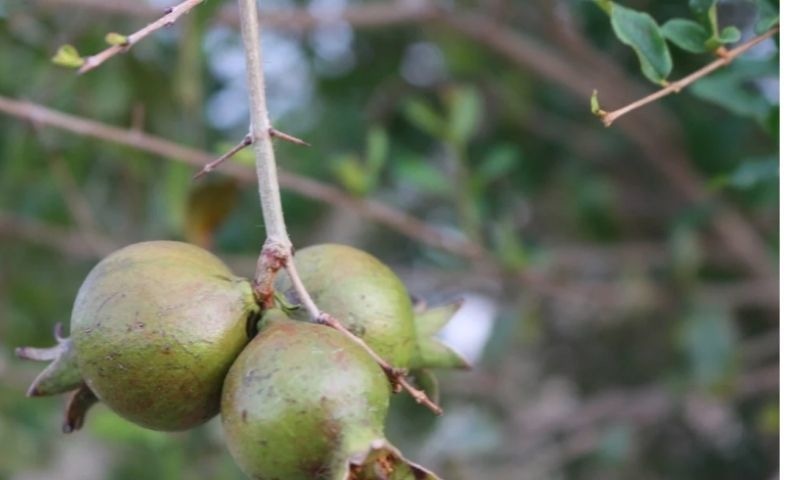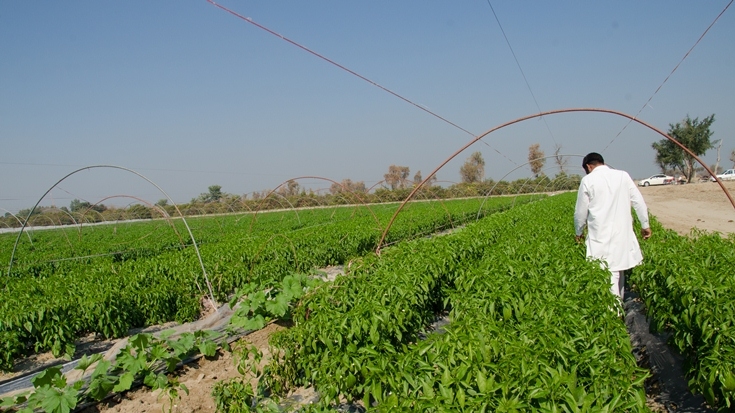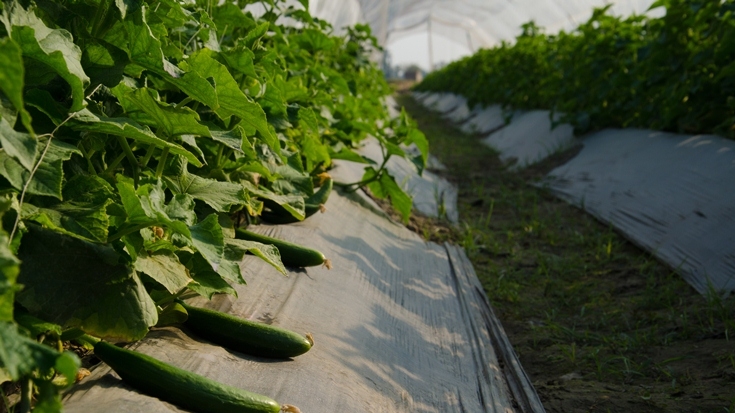ghazi52
PDF THINK TANK: ANALYST

- Joined
- Mar 21, 2007
- Messages
- 101,794
- Reaction score
- 106
- Country
- Location
Micro irrigation for sustainable agriculture
Dr Bashir Ahmad
July 4, 2021
The focus should be on orchard and vegetable production with drip irrigation close to the CPEC economic zones

Agro farm on drip stretching over 700 acres in Bahawalpur desert — Photo courtesy: Infiniti Farm
The dwindling water resources of Pakistan are under continuous pressure due to rapid population growth and climate change-induced risks. Meeting the increasing water demands is a challenge for the policy-makers, planners and researchers as well as the end users. In view of the looming water crisis, efficient and economical use of scarce water resources is an imperative.
Unfortunately, the efficiency of existing surface irrigation systems is less than 40 percent. Inadequate water storage, sedimentation of existing reservoirs, falling groundwater levels, low land and water productivity are some of the major challenges to water resources in the country.
The agriculture sector is amongst the largest water consumers globally. Around 93 percent of water is consumed by agriculture, 4 percent by industry and 3 percent by domestic users. The agriculture sector is often criticised for its low efficiency and excessive water losses. Due to increasing water demand in other sectors, particularly industry and domestic, it is very unlikely that more water resources will be made available for the agriculture sector in the future.
To meet the increasing food requirements, irrigated agriculture has to produce more with less water by adopting efficient micro-irrigation systems like drip, sprinkler and responsive methods. These irrigation methods need to be more-efficient, cost-effective, reliable and flexible.
The irrigation efficiency of drip and sprinkler irrigation systems is more than double the efficiency of traditional surface irrigation methods. However, their adoption is very low in Pakistan so far.
Keeping in view the current situation, accelerated and sustainable adoption of micro-irrigation, especially drip irrigation, is urgently needed.
Global overview of micro irrigation technologies
Drip and sprinkler irrigation systems have been developed and successfully adopted in various countries of the world, including the US, Australia, China, India, Turkey, Brazil and Israel. The last two have witnessed a quantum leap in the expansion of micro irrigation technology.
Israel and Uzbekistan have adopted this on 100 percent of their areas, whereas 57 percent, 56 percent and 37 percent areas of the US, Brazil and Australia, respectively, are under drip and sprinklers. The adoption of drip and sprinkler systems has reduced water use in irrigation by 27 percent in China and 35 percent in Australia.
In Asia, the most significant gains have been achieved in China and India, the world’s top two irrigators, where the area under micro-irrigation has expanded 88-fold and 111-fold, respectively, over the last two decades.
India now leads the world, with nearly 5 million hectares (about 13 million acres) under micro-irrigation methods. Contrarily, in Pakistan these technologies are still in their infancy with installations on only a fraction of irrigated area. The worldwide micro-irrigation adoption grew slowly but steadily. It was 1.08 million acres in 1981 and has now reached about 128 million acres (52 M ha), showing a nine-fold increase.
The last 15 years (2000-2015) have witnessed a quantum leap in the expansion of micro-irrigation technologies, both in the developed and developing countries.
The outcome in Pakistan
Despite multiple attempts to introduce and upscale micro irrigation systems in the country during the last three decades by Pakistan Agriculture Research Council (PARC) and its various partners, unfortunately, the outcome has not been satisfactory. The government of Pakistan has been providing huge subsidies to farmers for installation of micro-irrigation. However, with all efforts and subsidies, the adoption of micro-irrigation in Pakistan is not at a scale comparable with other countries of the world.
About 75,000 acres in the Punjab and 5,000 acres in Sindh have been brought under micro irrigation under current initiatives by provincial On-Farm Water Management Departments. Since micro-irrigation is highly successful in the world and significantly contributing to the economy of many countries, we need to assess the slow adoption in Pakistan.
Why do farmers prefer traditional irrigation practices? Is it due to lack of knowledge and non-availability of necessary services for modern irrigation technologies? One of the main limitations for its adoption and operation is high operational fuel cost. Farmers usually abandon these systems after 1-2 years of operation due to the high electricity cost.
Luckily, with the introduction of solar water pumping and its integration with micro-irrigation by the PARC, now micro-irrigation technology is taking off. There are success stories spreading over the landscape of Pakistan, where pioneering and progressive farmers have adopted the full micro-irrigation package. Private farms at Kallar Kahar have done wonders, turning the difficult terrain into productive agricultural land.
Another private farm stretching over 700 acres on drip irrigation system in the Cholistan desert is worth mentioning. There are good success stories of individual farmers who are rejuvenating sand dunes in Cholistan, Thal, rugged Balochistan and arid DG Khan through drip irrigation and are role models for farming communities.
Success stories of drip irrigation for orchard and vegetable production have happened mostly under provincial On-Farm Water Management Departments (OFWM) projects. Another PARC initiative of portable solar pumping is being widely adopted in Thal and kacha areas along the River Indus.
Progressive farmers are getting yields comparable to the developed countries but not good monetary returns. This is due to poor market linkages, lack of value chains and non-existence of follow-up of agronomic practices by public institutions. OFWM is providing effective advisory services on irrigation and water management but agronomic practices, crop varieties and plant protection knowledge of the farmers is weak and needs to be updated.
There is a dire need to properly document, publish and disseminate these success stories and inform the public to promote micro-irrigation across the country. This will dispel the myth that micro-irrigation does not fulfil the irrigation requirement.
Recommendations on way forward
Israel has succeeded in advancing irrigated agriculture on a wide scale on arid and semi-arid lands, with an intensive use of technology and capital and a firm state-led irrigation policy. For this to happen in Pakistan, there must be a clear roadmap and strategy which must have popular support across the board. The strategy and approach must be simple, consistent and holistic. Some of the main points may be:
Documentation and wider dissemination of success stories of drip irrigation for growing orchards in the desert under marginal land and water conditions.
Incentivising local manufacturing of micro-irrigation components to reduce price and make it affordable for small holder farmers. This will not only lower price, increase production but also create jobs.
Service companies should be made accountable for compliance of follow up on repair and maintenance for the stipulated period.
The federal government must facilitate research and development support for low-cost local fabrication of micro irrigation equipment and incentivise service provider companies.
The subsidy policy should be revised to favour small landholders. Influential but absentee farmers have been the major beneficiaries of public subsidies of micro-irrigation which now should be provided to small and on-site farmers.
Training of farmers in the use of new technology with advisory service on agronomic practices, crop varieties, diseases and post-harvest interventions will be important confidence building measures.
There must be proportionate public investment on canal-fed irrigation and micro irrigation sectors outside the Indus irrigation system. Canal-irrigated areas are a major beneficiary of national water resources free of cost on the one hand and prime beneficiary of public investments (irrigational infrastructure including dams, barrages, canals and headworks). Irrigated areas consume more than 95 percent of water and irrigation development budget whereas micro irrigation schemes outside canal irrigation areas get a fractional share.
On-Farm Water Management services may be segregated and separated for canal irrigation regime and Micro-Irrigation Department for rain-fed areas. This will make sense of rational fund allocations and performance competition.
Micro-irrigation should be granted an industry status. Integrated packages, including solar pumping, micro irrigation and green house tunnels for vegetable production can do wonders.
The government of Pakistan must set up a task force on micro irrigation like India did in 2003. It impressively supported adoption of this technology on more than 13 million acres.
Proper market access and value chain needs to be established to provide fair economic return to the farmers.
Micro irrigation, particularly drip irrigation, may be confined to horticultural crops, including fruits and vegetables and priority be given to desert, semi-desert and water scarce sandy areas, including the Potohar plateau and command areas of mini and small dams.
The focus should be on orchard and vegetable production with drip near the CPEC economic zones so that exports can be arranged easily.
Dr Bashir Ahmad
July 4, 2021
The focus should be on orchard and vegetable production with drip irrigation close to the CPEC economic zones

Agro farm on drip stretching over 700 acres in Bahawalpur desert — Photo courtesy: Infiniti Farm
The dwindling water resources of Pakistan are under continuous pressure due to rapid population growth and climate change-induced risks. Meeting the increasing water demands is a challenge for the policy-makers, planners and researchers as well as the end users. In view of the looming water crisis, efficient and economical use of scarce water resources is an imperative.
Unfortunately, the efficiency of existing surface irrigation systems is less than 40 percent. Inadequate water storage, sedimentation of existing reservoirs, falling groundwater levels, low land and water productivity are some of the major challenges to water resources in the country.
The agriculture sector is amongst the largest water consumers globally. Around 93 percent of water is consumed by agriculture, 4 percent by industry and 3 percent by domestic users. The agriculture sector is often criticised for its low efficiency and excessive water losses. Due to increasing water demand in other sectors, particularly industry and domestic, it is very unlikely that more water resources will be made available for the agriculture sector in the future.
To meet the increasing food requirements, irrigated agriculture has to produce more with less water by adopting efficient micro-irrigation systems like drip, sprinkler and responsive methods. These irrigation methods need to be more-efficient, cost-effective, reliable and flexible.
The irrigation efficiency of drip and sprinkler irrigation systems is more than double the efficiency of traditional surface irrigation methods. However, their adoption is very low in Pakistan so far.
Keeping in view the current situation, accelerated and sustainable adoption of micro-irrigation, especially drip irrigation, is urgently needed.
Global overview of micro irrigation technologies
Drip and sprinkler irrigation systems have been developed and successfully adopted in various countries of the world, including the US, Australia, China, India, Turkey, Brazil and Israel. The last two have witnessed a quantum leap in the expansion of micro irrigation technology.
Israel and Uzbekistan have adopted this on 100 percent of their areas, whereas 57 percent, 56 percent and 37 percent areas of the US, Brazil and Australia, respectively, are under drip and sprinklers. The adoption of drip and sprinkler systems has reduced water use in irrigation by 27 percent in China and 35 percent in Australia.
In Asia, the most significant gains have been achieved in China and India, the world’s top two irrigators, where the area under micro-irrigation has expanded 88-fold and 111-fold, respectively, over the last two decades.
India now leads the world, with nearly 5 million hectares (about 13 million acres) under micro-irrigation methods. Contrarily, in Pakistan these technologies are still in their infancy with installations on only a fraction of irrigated area. The worldwide micro-irrigation adoption grew slowly but steadily. It was 1.08 million acres in 1981 and has now reached about 128 million acres (52 M ha), showing a nine-fold increase.
The last 15 years (2000-2015) have witnessed a quantum leap in the expansion of micro-irrigation technologies, both in the developed and developing countries.
The outcome in Pakistan
Despite multiple attempts to introduce and upscale micro irrigation systems in the country during the last three decades by Pakistan Agriculture Research Council (PARC) and its various partners, unfortunately, the outcome has not been satisfactory. The government of Pakistan has been providing huge subsidies to farmers for installation of micro-irrigation. However, with all efforts and subsidies, the adoption of micro-irrigation in Pakistan is not at a scale comparable with other countries of the world.
About 75,000 acres in the Punjab and 5,000 acres in Sindh have been brought under micro irrigation under current initiatives by provincial On-Farm Water Management Departments. Since micro-irrigation is highly successful in the world and significantly contributing to the economy of many countries, we need to assess the slow adoption in Pakistan.
Why do farmers prefer traditional irrigation practices? Is it due to lack of knowledge and non-availability of necessary services for modern irrigation technologies? One of the main limitations for its adoption and operation is high operational fuel cost. Farmers usually abandon these systems after 1-2 years of operation due to the high electricity cost.
Luckily, with the introduction of solar water pumping and its integration with micro-irrigation by the PARC, now micro-irrigation technology is taking off. There are success stories spreading over the landscape of Pakistan, where pioneering and progressive farmers have adopted the full micro-irrigation package. Private farms at Kallar Kahar have done wonders, turning the difficult terrain into productive agricultural land.
Another private farm stretching over 700 acres on drip irrigation system in the Cholistan desert is worth mentioning. There are good success stories of individual farmers who are rejuvenating sand dunes in Cholistan, Thal, rugged Balochistan and arid DG Khan through drip irrigation and are role models for farming communities.
Success stories of drip irrigation for orchard and vegetable production have happened mostly under provincial On-Farm Water Management Departments (OFWM) projects. Another PARC initiative of portable solar pumping is being widely adopted in Thal and kacha areas along the River Indus.
Progressive farmers are getting yields comparable to the developed countries but not good monetary returns. This is due to poor market linkages, lack of value chains and non-existence of follow-up of agronomic practices by public institutions. OFWM is providing effective advisory services on irrigation and water management but agronomic practices, crop varieties and plant protection knowledge of the farmers is weak and needs to be updated.
There is a dire need to properly document, publish and disseminate these success stories and inform the public to promote micro-irrigation across the country. This will dispel the myth that micro-irrigation does not fulfil the irrigation requirement.
Recommendations on way forward
Israel has succeeded in advancing irrigated agriculture on a wide scale on arid and semi-arid lands, with an intensive use of technology and capital and a firm state-led irrigation policy. For this to happen in Pakistan, there must be a clear roadmap and strategy which must have popular support across the board. The strategy and approach must be simple, consistent and holistic. Some of the main points may be:
Documentation and wider dissemination of success stories of drip irrigation for growing orchards in the desert under marginal land and water conditions.
Incentivising local manufacturing of micro-irrigation components to reduce price and make it affordable for small holder farmers. This will not only lower price, increase production but also create jobs.
Service companies should be made accountable for compliance of follow up on repair and maintenance for the stipulated period.
The federal government must facilitate research and development support for low-cost local fabrication of micro irrigation equipment and incentivise service provider companies.
The subsidy policy should be revised to favour small landholders. Influential but absentee farmers have been the major beneficiaries of public subsidies of micro-irrigation which now should be provided to small and on-site farmers.
Training of farmers in the use of new technology with advisory service on agronomic practices, crop varieties, diseases and post-harvest interventions will be important confidence building measures.
There must be proportionate public investment on canal-fed irrigation and micro irrigation sectors outside the Indus irrigation system. Canal-irrigated areas are a major beneficiary of national water resources free of cost on the one hand and prime beneficiary of public investments (irrigational infrastructure including dams, barrages, canals and headworks). Irrigated areas consume more than 95 percent of water and irrigation development budget whereas micro irrigation schemes outside canal irrigation areas get a fractional share.
On-Farm Water Management services may be segregated and separated for canal irrigation regime and Micro-Irrigation Department for rain-fed areas. This will make sense of rational fund allocations and performance competition.
Micro-irrigation should be granted an industry status. Integrated packages, including solar pumping, micro irrigation and green house tunnels for vegetable production can do wonders.
The government of Pakistan must set up a task force on micro irrigation like India did in 2003. It impressively supported adoption of this technology on more than 13 million acres.
Proper market access and value chain needs to be established to provide fair economic return to the farmers.
Micro irrigation, particularly drip irrigation, may be confined to horticultural crops, including fruits and vegetables and priority be given to desert, semi-desert and water scarce sandy areas, including the Potohar plateau and command areas of mini and small dams.
The focus should be on orchard and vegetable production with drip near the CPEC economic zones so that exports can be arranged easily.
The writer is Climate, Energy and Water Resources Institute (CEWRI) director at the National Agricultural Research Centre (NARC)

 www.thenews.com.pk
www.thenews.com.pk

Micro irrigation for sustainable agriculture | Political Economy | thenews.com.pk
The focus should be on orchard and vegetable production with drip irrigation close to the CPEC economic zones
















